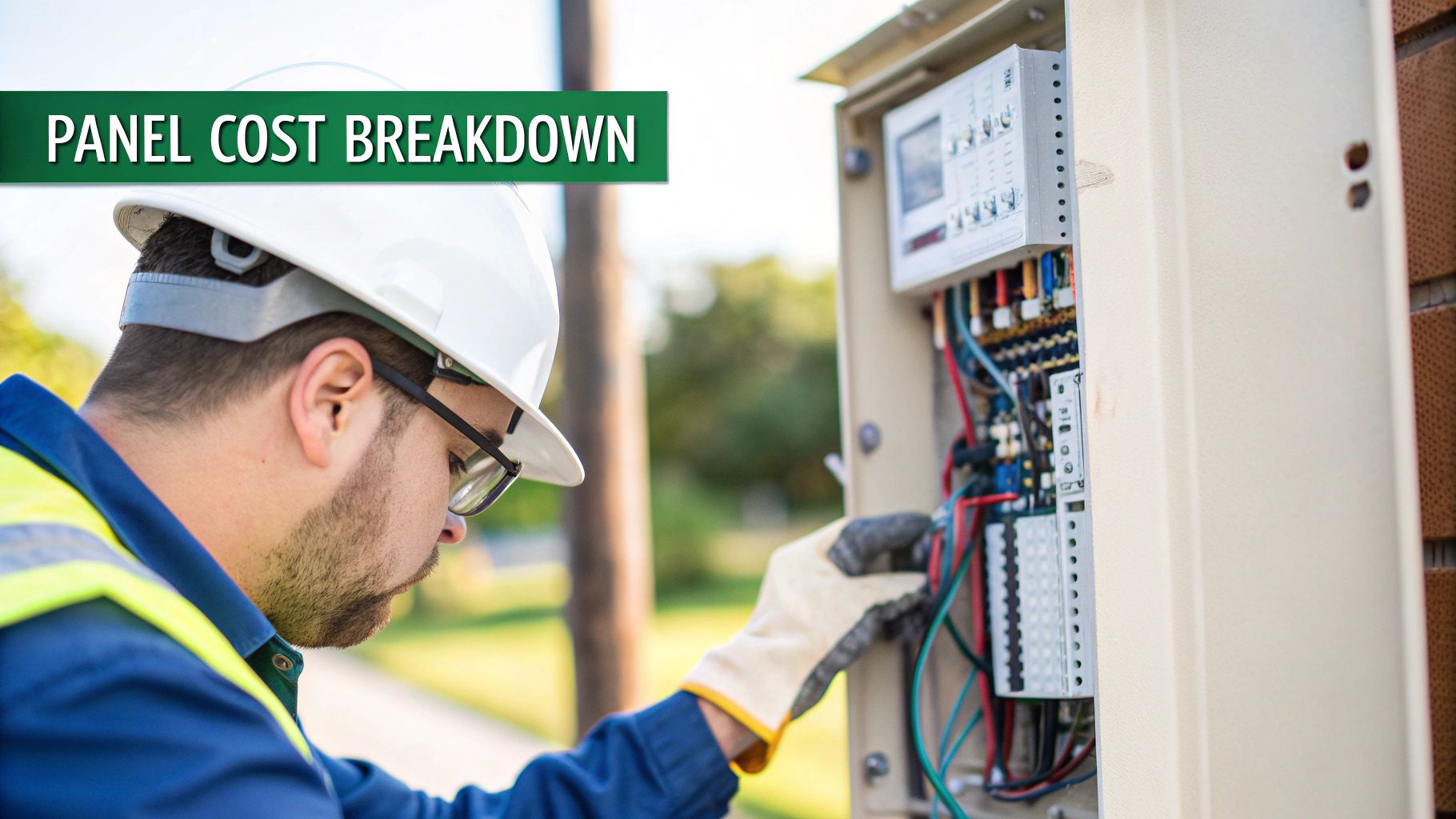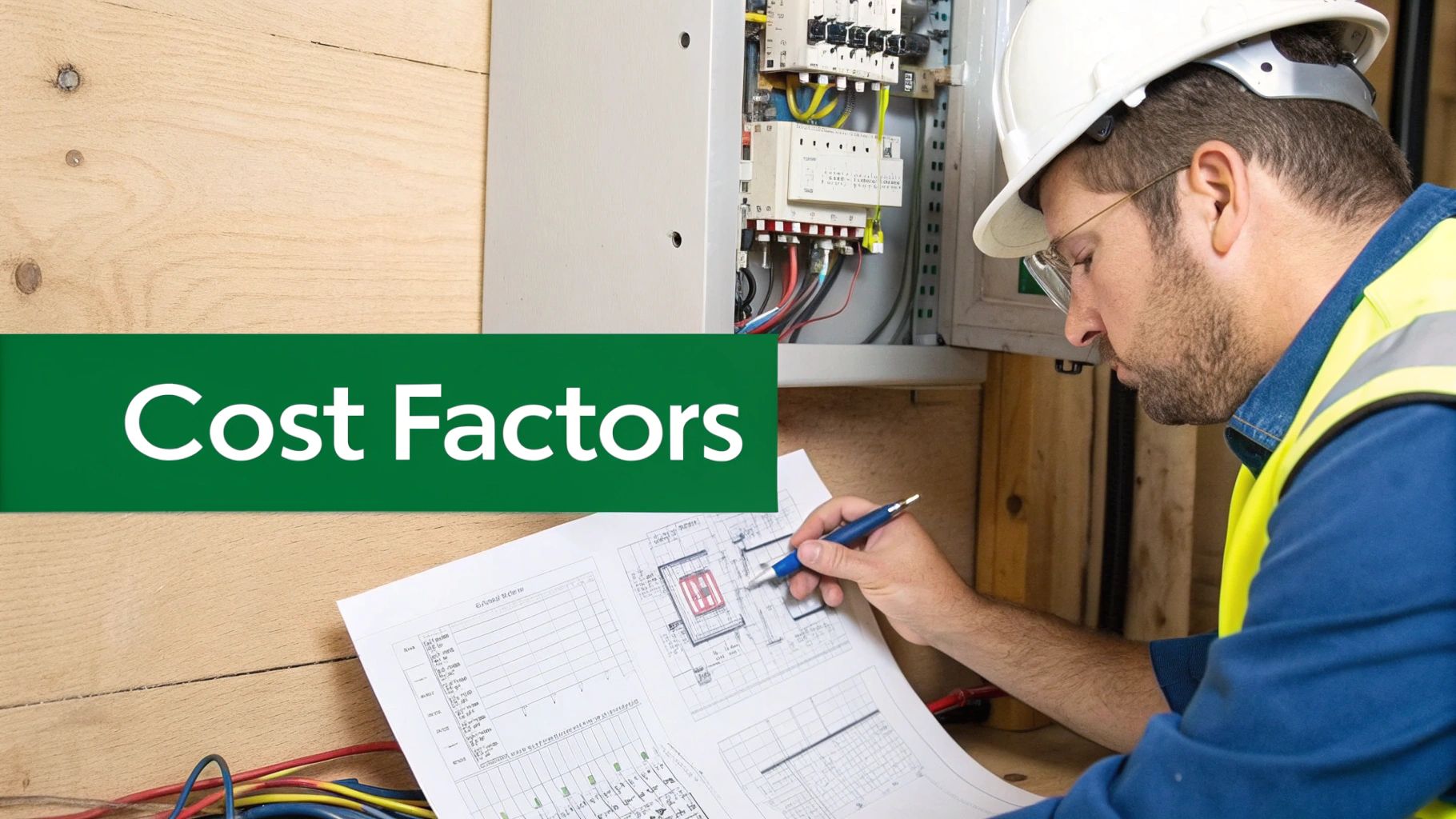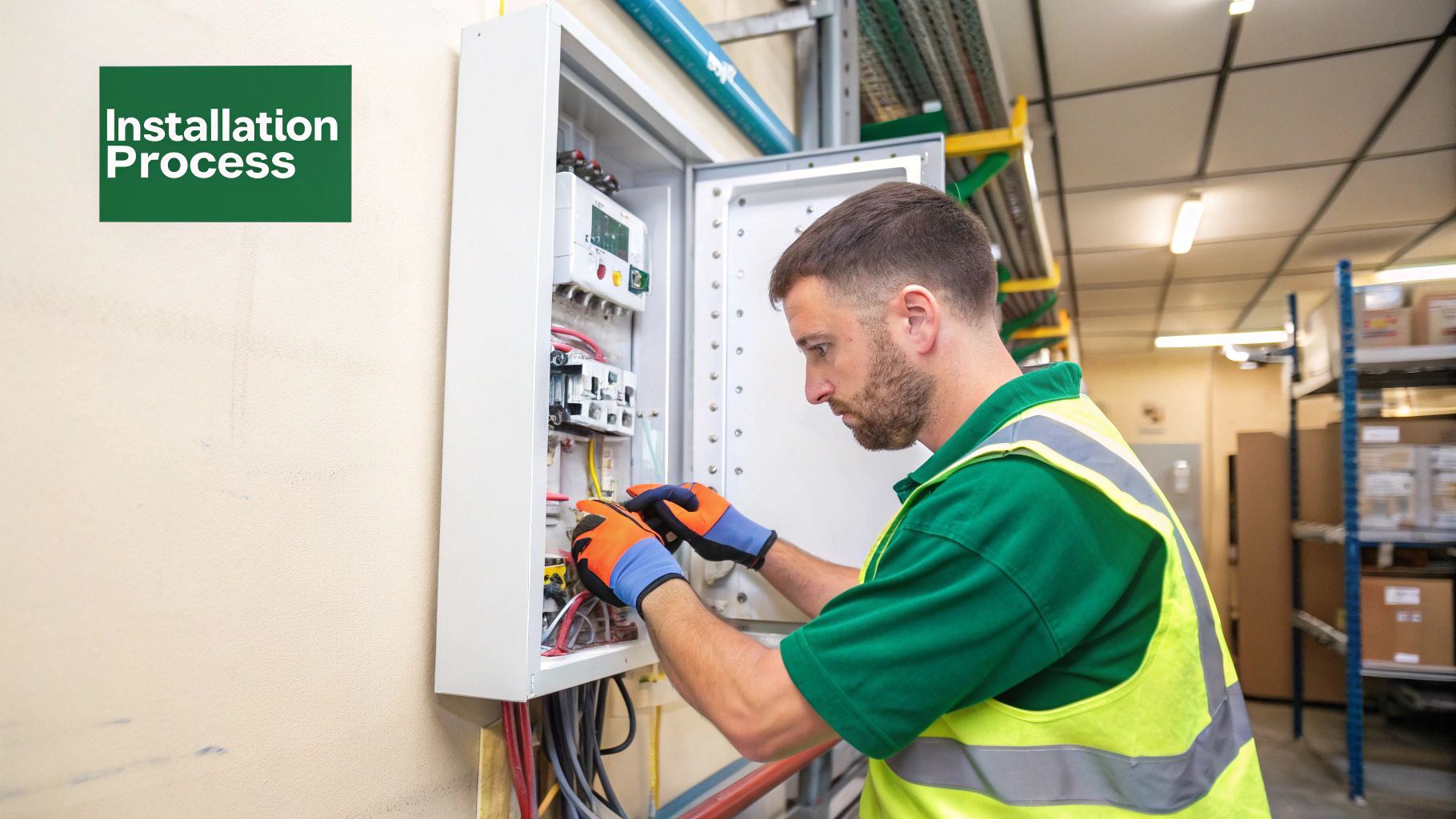Quick Answer: Key Takeaways on Electrical Panel Costs
- Standard Replacement (100-Amp): You can expect to pay between $4,800 and $8,000 for a basic panel replacement. This is suitable for smaller, older homes with modest electrical needs.
- Modern Upgrade (200-Amp): Upgrading to a 200-amp service, necessary for most modern homes, typically costs $4,800 and $8,000. This supports EV chargers, smart homes, and high-demand appliances.
- Biggest Cost Factor: Professional labor makes up the largest portion of the final price (often 70-80%), covering the electrician’s expertise, licensing, and ensuring the job is done safely and to code.
- Why Choose Phase3Electric? Unlike faceless corporate services, Phase3Electric is your reliable local expert. We combine technical mastery with genuine care for our community, and we actually answer the phone. We’re here to provide straight answers and safe, high-quality installations.
At Phase3Electric, we get this question all the time, and we believe in giving you a straight answer. So, let’s get right to it.
Here’s a quick snapshot of what you can generally expect to pay for a new electrical panel:
- For a standard 100-amp panel replacement, you’re typically looking at a range of $4,800 and $8,000.
- If you’re upgrading to a 200-amp service—a popular choice for modern homes with more electronics—the cost usually falls between $4,800 and $8,000, sometimes more.
- Keep in mind, your final price tag will shift based on your panel’s amperage, local labor rates, and any extra work needed, like new wiring or city permits.
Your Quick Guide to Electrical Panel Costs
Trying to figure out “how much does a new electrical panel cost?” can feel like you’re navigating a maze. We’re here to cut through the confusion. Think of your electrical panel as the heart of your home’s electrical system—it pumps power everywhere it needs to go. Investing in a new one is a big deal for both safety and convenience.
The total cost isn’t just one number; it’s a mix of a few key things: the panel itself, the electrician’s time and expertise, and any permits your city requires. National averages from resources like Homewyse’s cost breakdown show that a standard 100-amp installation often lands somewhere between $1,283 and $1,556. This covers the panel, materials, and the labor to get it all hooked up correctly.
To help you budget, it’s useful to see how those costs break down. Here’s a look at what goes into a typical 100-amp panel installation.
Estimated Cost Breakdown for a Standard 100-Amp Panel
This table provides a clearer picture of where your money goes when installing a standard 100-amp panel.
| Cost Component | Average Price Range |
|---|---|
| Electrical Panel (100-Amp) | $111 – $200 |
| Installation Materials | $150 – $300 |
| Professional Labor | $2,000 – $4,200+ |
As you can see, the bulk of the cost is in the professional labor. This reflects the skill, time, and safety certifications required to do the job right, ensuring your home is both powered and protected.
Why Your Electrical Panel Is the Heart of Your Home

It’s easy to overlook, but your electrical panel is really the heart of your home’s entire electrical system. It’s the central hub that takes the main power feed from the utility company and safely directs it to every single outlet, light, and appliance in your house.
Think of it like an air traffic controller for your home’s electricity. Its main job is to manage the flow of power, preventing overloads (too many things running at once) and short circuits that could otherwise lead to disaster. Without it, you wouldn’t be able to run your coffee maker in the morning or charge your phone at night.
What Do Circuit Breakers Do?
Those little switches inside the panel are called circuit breakers. Each one is assigned to a specific circuit, like the kitchen outlets or the master bedroom. If a circuit starts drawing too much power, the breaker senses the danger and trips, instantly shutting off the electricity to that area.
This simple, automatic action is what stops wires from overheating, which is a major fire hazard.
An old or faulty panel just can’t keep up with the demands of modern life, and that creates a serious safety risk. This is why figuring out the cost of a new electrical panel isn’t just about a home repair—it’s a critical investment in your home’s safety and functionality.
At Phase3Electric, we want to help you make that investment with total confidence.
What Goes Into the Final Cost of a New Panel?

Figuring out the final price for a new electrical panel is a lot like getting a quote for any other major home project. It’s not one single number, but a combination of moving parts—the equipment itself, the expert doing the work, and a few other variables that can pop up.
When you get an estimate from an electrician, you’re seeing a breakdown of these different elements. Let’s peel back the layers so you can understand exactly what you’re paying for.
The Big Two: Materials and Labor
The first thing that impacts the price is the panel’s amperage. A 100-amp panel might be perfectly fine for a smaller, older home with modest electrical needs. But if you’re powering a modern house with all the gadgets, or planning for an EV charger, you’ll likely need a 200-amp panel. That extra capacity means a higher upfront material cost.
Panel brand matters, too. You’ll see names like Siemens and Square D, which might cost a bit more, but they’ve earned a reputation for being incredibly reliable and lasting for decades.
But here’s the most important part:
Labor costs almost always make up the biggest slice of the pie, typically accounting for 70-80% of the total project price.
This isn’t just for the electrician’s time on-site. You’re paying for years of training, proper licensing, insurance, and the peace of mind that comes from knowing the job is done safely and meets all legal codes. A more complicated installation, like moving the panel to a new wall or running new service lines from the utility pole, naturally takes more time and skill, which will be reflected in the labor cost.
For a business, this installation period also means downtime. To get a handle on what that could mean for your bottom line, our downtime cost calculator can help you budget for the whole project, not just the electrician’s bill.
Other Costs to Keep in Mind
Beyond the panel and the hands installing it, a few other expenses can surface.
- Permits: Your city or county will almost certainly require a permit for this kind of work. These fees, which can run anywhere from $50 to over $300, cover the cost of a safety inspection to ensure everything is up to code.
- Wiring Repairs: An electrician might discover that some of your home’s wiring is old, frayed, or not up to modern standards. To connect it safely to the new panel, some of that wiring may need to be repaired or replaced.
- Structural Work: Sometimes, the new panel is physically larger than the old one. This might require some minor drywall or framing adjustments to make it fit properly.
Is It Time to Upgrade to a 200-Amp Panel?
Our homes are hungrier for power than ever before. Think about it: smart home gadgets, high-efficiency appliances, and maybe even an EV charger installation in the garage. All these modern conveniences put a heavy strain on our electrical systems. If you’re living in an older home, you likely have a 100-amp panel, which is often just not enough to keep up.
Are you constantly heading to the basement to flip a breaker? That’s a classic sign your panel is overloaded. If running the microwave while the AC is on feels like a gamble, your system is telling you it’s struggling. This isn’t just annoying; it’s a potential safety hazard.
Why a 200-Amp Upgrade Is a Smart Investment
Jumping to a 200-amp panel isn’t just about fixing a problem—it’s about preparing your home for the future. It’s a crucial step if you’re planning a big project like a kitchen remodel, adding a new room, or getting ready for an electric vehicle.
A 200-amp panel provides the electrical backbone your home needs to handle new technology safely and reliably. More than that, it can increase your property value by showing potential buyers that your home is ready for modern demands.
Let’s break down the key differences between a standard 100-amp panel and the more robust 200-amp upgrade. The right choice depends on your current needs and future plans.
Comparing 100-Amp vs 200-Amp Panel Upgrades
| Feature | 100-Amp Panel | 200-Amp Panel |
|---|---|---|
| Capacity | Adequate for smaller, older homes with few major appliances. | Necessary for modern homes with central AC, electric heat, and multiple large appliances. |
| Best For | Homes under 1,500 sq. ft. with gas appliances. | Larger homes or any home with high-demand devices like EV chargers, hot tubs, or electric ranges. |
| Future-Proofing | Limited. May struggle with future additions or new tech. | Excellent. Provides ample power for future renovations and technological advancements. |
| Cost | Less expensive upfront, but may need replacing sooner. | Higher initial investment but adds long-term value and capacity. |
Ultimately, a 200-amp panel provides the peace of mind that comes with knowing your home’s electrical system can handle whatever you throw at it.
Budgeting for Your Upgrade
So, what does this kind of upgrade actually cost? Making the jump from 100 amps to 200 amps is a common job, and you can generally expect the price to land somewhere between $5,000 and $9,000. This estimate typically covers the new panel itself, the more intensive labor involved, and any required permits.
Of course, every project is different. Simple swaps will be on the lower end, but if the job requires significant rewiring or other complications, the cost can climb. In some cases, a complex upgrade could run you more than $4,000.
When a Subpanel Is the Smarter Solution

Sometimes, a full panel replacement is just overkill. Think of it like this: you wouldn’t rebuild an entire highway just to add a new exit ramp. If your new power needs are all in one spot—like a new workshop, a finished basement, or a home office—a complete overhaul can be a huge, unnecessary expense.
This is where a subpanel comes in. It’s essentially a mini electrical panel that branches off your main one. Its job is to manage the power for a specific, dedicated space, giving you the extra circuits you need without tearing into your home’s entire electrical system.
A Cost-Effective Power Boost
A subpanel is a fantastic, budget-friendly way to expand your electrical capacity right where you need it. Let’s say you’re finally installing that hot tub or setting up a woodworking shop in the garage. A subpanel provides the necessary power for those high-demand items, isolating them from the rest of your home so you don’t overload the main panel.
When your power needs are localized, installing a subpanel is almost always the more affordable option. You get safe, reliable power without the higher cost and major hassle of a full main panel upgrade.
So, what’s the cost? Installing a subpanel typically ranges from $400 to $3000 based on the distance from the current electrical panel and the pathway to get there. A smaller 50-amp subpanel might be on the lower end of that range, while a 100-amp subpanel installation could start closer to $500.
The final price tag depends on a few things:
- The amperage of the panel itself
- How many circuits you need
- The cost of permits, which can add $50 to $300
For a deeper dive into the numbers, you can explore detailed breakdowns of subpanel pricing from Angi.
Your Home’s Electrical System: A Smart and Safe Investment
Making the call to upgrade your home’s electrical system is a big one. It’s a decision that touches everything from your family’s safety to the simple conveniences you rely on every day. Here at Phase3Electric, we’ve always believed that the best customer is an informed one. When you understand the what and why, you’re in a much better position to make the right choice for your home.
Think of it this way: if you start noticing things like flickering lights, a strange buzzing from your panel, or breakers that seem to trip just by looking at them, that’s your house talking to you. These aren’t just little quirks to ignore. They’re clear signals that your system is overloaded or outdated, and it’s time to start looking into what a new electrical panel might cost.
The single most important thing you can do is bring in a licensed and insured electrician. You need someone who lives and breathes safety codes and knows how to explain the work clearly. A true professional protects your family and your home—no shortcuts, just quality work.
With the right information, you can feel confident in your next steps. Whether you’re looking at a straightforward panel replacement or a more complex project, our team is here to guide you. We handle everything from residential upgrades to complex installations for businesses—you can see some of our commercial electrical services to get a sense of our full range of expertise. We’re ready to help you make a secure, intelligent investment in the heart of your home.
Got Questions About Electrical Panels? We’ve Got Answers.
Deciding on a big home project like a new electrical panel always brings up a lot of questions. We get it. As electricians who spend our days in homes just like yours, we’ve heard just about everything.
Here are the answers to some of the most common questions we get, laid out in plain English to help you feel confident about your decision.
How Long Does an Electrical Panel Last?
Most modern electrical panels are built to last, typically giving you 25 to 40 years of service. But that number isn’t a guarantee. Think of it like the tires on your car—how long they last depends heavily on how you use them.
A panel in a home with a huge electrical load (think multiple EVs, a hot tub, and all the latest gadgets) or one exposed to moisture in a damp basement might give out much sooner.
Here are a few tell-tale signs that your panel is on its last legs:
- Breakers are constantly tripping for no apparent reason.
- You notice a faint but persistent burning smell coming from the panel area.
- Your lights flicker or dim whenever a large appliance kicks on.
- There’s visible rust or corrosion on the panel box or breakers.
What Is a Smart Electrical Panel?
A smart electrical panel is a major upgrade from the old metal box you’re used to. While a traditional panel is a simple “on/off” switch for your home’s power, a smart panel is more like the central command center for your entire electrical system.
Simply put, a smart panel is the brain of your home’s electrical network. It lets you see exactly how much energy each circuit is using, right from an app on your phone. You can schedule your water heater to run during off-peak hours to save money or intelligently manage your solar battery power during a blackout. It’s a huge leap forward in both home efficiency and safety.
Is It Safe to Do a DIY Panel Replacement?
In a word: no. We can’t stress this enough. Replacing an electrical panel is one of the most dangerous jobs you could possibly attempt on your own. You’re dealing with live, high-voltage wires coming directly from the street—a single mistake can be fatal.
Beyond the immediate danger, a botched installation creates a massive fire risk, can fry your expensive electronics, and is guaranteed to fail a safety inspection. This is a job that should only ever be handled by a licensed and insured electrician who knows the local codes and safety procedures inside and out. It’s just not worth the risk.
